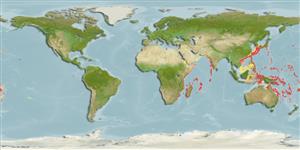>
Beryciformes (Sawbellies) >
Berycidae (Alfonsinos)
Etymology: Beryx: Greek, beryx or berys = a name of a fish. Cuvier & Valenciennes (1829:221) precise that the name was used by Gesner from Varinus, but with no indication whatsoever helping identifying any species. After D'Arcy Wentworth Thompson (A glossary of Greek fishes, 1947), the name actually seems to come originally from Hesychius, but perhaps the name was not originally a fish name. Thompson compares it to meryx (ruminant), applied on skaros (Scarus), so it may have been applied on a parrot fish referring to its browsing/grazing behavior described by Aristoteles and followers.
Environment: milieu / climate zone / rango de profundidad / distribution range
Ecología
marino bentopelágico; rango de profundidad 100 - 500 m (Ref. 42565). Deep-water
Northwest Pacific: Japan. Also known from the Western Indian Ocean.
Tamaño / Peso / Age
Madurez: Lm ? range ? - ? cm
Max length : 30.0 cm SL macho / no sexado; (Ref. 42565)
Short description
Claves de identificación | Morfología | Morfometría
Espinas dorsales (total) : 4; Radios blandos dorsales (total) : 12 - 13; Espinas anales: 4; Radios blandos anales: 27 - 32.
Body shape (shape guide): fusiform / normal.
Life cycle and mating behavior
Madurez | Reproducción | Puesta | Huevos | Fecundidad | Larva
Hayashi, M., 2002. Berycidae. p. 485-486. In T. Nakabo (ed.). Fishes of Japan with pictorial keys to the species (second edition). Tokai University Press, 1749 p. (Ref. 42565)
IUCN Red List Status (Ref. 130435: Version 2025-1)
Threat to humans
Harmless
Human uses
Herramientas
Special reports
Download XML
Fuentes de Internet
Estimates based on models
Preferred temperature (Referencia
123201): 12.6 - 21.3, mean 16.2 °C (based on 189 cells).
Phylogenetic diversity index (Referencia
82804): PD
50 = 0.6260 [Uniqueness, from 0.5 = low to 2.0 = high].
Bayesian length-weight: a=0.01122 (0.00514 - 0.02450), b=3.04 (2.87 - 3.21), in cm total length, based on all LWR estimates for this body shape (Ref.
93245).
Nivel trófico (Referencia
69278): 3.9 ±0.5 se; based on size and trophs of closest relatives
Resiliencia (Referencia
120179): Bajo, población duplicada en un tiempo mínimo de 4.5-14 años (Preliminary K or Fecundity.).
Fishing Vulnerability (Ref.
59153): Low to moderate vulnerability (27 of 100).
🛈
